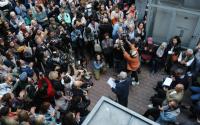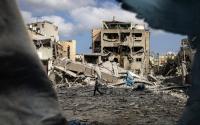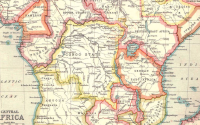They will probably be commemorating the wrong people in Kitty Hawk, North Carolina, tomorrow. Five months before the Wright brothers lifted a flying machine into the air for 12 seconds above the sand dunes of the Outer Banks, the New Zealander Richard Pearse had travelled for more than a kilometre in his contraption, without the help of ramps or slides, and had even managed to turn his plane in mid-flight.
But history belongs to those who record it, so tomorrow is the official centenary of the aeroplane. At Kitty Hawk, George Bush will deliver a eulogy to aviation, while a number of men with more money than sense will seek to recreate the Wrights' first flight. Well, they can keep their anniversary. Tomorrow should be a day of international mourning. December 17 2003 is the centenary of the world's most effective killing machine.
The aeroplane was not the first weapon of mass destruction. The European powers had already learned to rain terror upon their colonial subjects by means of naval bombardment, artillery and the Gatling and Maxim guns. But the destructive potential of aerial bombing was grasped even before the first plane left the ground. In 1886, Jules Verne imagined aircraft acting as a global police force, bombing barbaric races into peace and civilisation. In 1898, the novelist Samuel Odell saw the English-speaking peoples subjugating eastern Europe and Asia by means of aerial bombardment. In the same year, the writer Stanley Waterloo celebrated the future annihilation of inferior races from the air.
None of this was lost on the Wright brothers. When Wilbur Wright was asked, in 1905, what the purpose of his machine might be, he answered simply: "War." As soon as they were confident that the technology worked, the brothers approached the war offices of several nations, hoping to sell their patent to the highest bidder. The US government bought it for $30,000, and started test bombing in 1910. The aeroplane was conceived, designed, tested, developed and sold, in other words, not as a vehicle for tourism, but as an instrument of destruction.
In November 1911, eight years after the first flight, the Italian army carried out the first bombing raid, on a settlement outside Tripoli. Then as now, aerial bombardment was seen as a means of civilising uncooperative peoples. As Sven Lindqvist records in A History of Bombing, the imperial powers experimented freely with civilisation from the skies. Just as the Holocaust was prefigured by colonial genocide, so the bombing raids which reduced Guernica, Hamburg, Dresden, Tokyo and parts of London to ash had been rehearsed in north Africa and the Middle East.
As the enemy was reduced to a distant target in an inferior sphere, greater cruelties could be engineered than any effected before. The British knew what they were doing in Germany. Directive 22 to Bomber Command in 1942 ordered that the "aiming points" for fire-bombing be "built-up areas, not, for instance, the dockyards or aircraft factories". The Americans knew what they were doing in Japan. Major General Curtis LeMay, who incinerated 100,000 civilians in Tokyo, admitted: "We knew we were going to kill a lot of women and kids when we burned that town. Had to be done." Japan sought to negotiate peace, but the Allies refused to talk until they had taken their firebombing to its logical conclusion, in Hiroshima and Nagasaki. LeMay later became chief of staff of the US airforce. He was the man who, in 1964, promised to bomb Vietnam back into the stone age.
I doubt much mention will be made of all this at the centenary celebrations tomorrow. Instead we will be encouraged to concentrate upon the civil applications of this military technology. We will be told how the aeroplane has made the world a smaller place, how it has brought people closer together, fostering understanding and friendship. There is something in this: the people of powerful nations might be reluctant to permit their leaders to destroy the countries they have visited. But commercial flights, like military flights, are an instrument of domination. As tourists, we engage with the people of other nations on our own terms. The world's administrators can flit from place to place enforcing their mandate. The corporate jet-set shrinks the earth to fit its needs. Those with access to the aeroplane control the world.
The men who attacked New York and Washington on September 11 2001 drove one symbol of power into another. The aeroplane, more precisely than any other technology, represents the global ruling class. In the past we raised our eyes to the men on horseback. Today we raise our eyes to the heavens.
Those hijackers had turned the civilian product of a military technology back into a military technology, but even when used for strictly commercial purposes, the airliner remains a weapon of mass destruction. Last week the World Health Organisation calculated that climate change is causing 150,000 deaths a year. This figure excludes deaths caused by drought and famine, pests and plant diseases and conflicts over natural resources, all of which appear to be exacerbated by global warming. Flying is our most effective means of wrecking the planet: every passenger on a return journey from Britain to Florida produces more carbon dioxide than the average motorist does in a year. Every time we fly, we help to kill someone.
This morning, our government is expected to give a grand 100th birthday present to the aeroplane. Despite almost 400,000 objections to the expansion of airports in Britain, the transport secretary will announce new runways at Stansted and Birmingham, and more flights to Heathrow. This, the government hopes, will help accommodate a near-tripling of the number of journeys into and out of Britain by 2030. By then the 400,000 won't be the only ones wishing that Wilbur and Orville (if indeed they were responsible) had stuck to mending bicycles.
The $1,000 those men spent on developing their beast is just about the only expenditure on this doom machine that has not been state-assisted. All over the world, the aircraft industry was built by means of government spending. All over the world, it is sustained today through tax breaks and hidden subsidies. Mysteriously exempt from both fuel duty and VAT, airlines in Britain dodge some £10bn of tax a year. The aeroplane, in other words, is still treated by governments as a social good.
This might have something to do with the fact that prime ministers and presidents use it more often than anyone else. Or it might reflect the perennial male obsession with the instruments of control.
Just as Alexander the Great worshipped his horse, George Bush, the new conqueror of Persia, will tomorrow worship the aeroplane. Our societies are built upon these technologies of war: the current world order fell from the hatches of the aeroplane. At 10.35am, North Carolina time, George Bush and the other enthusiasts for domination will bow down before it. The rest of us should observe 12 seconds of silence, in commemoration of the deeds wrought by those magnificent men in their killing machines.
· The sources for this and all George Monbiot's recent articles can be found at www.monbiot.com






